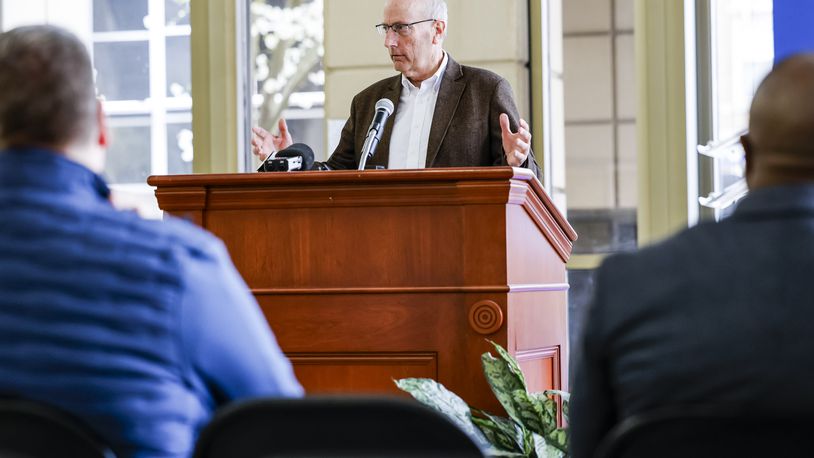The OneOhio Grant Portal is set to make $7.1 million in opioid recovery funds available for Region 14. There are 19 OneOhio regions, and the 2024 regional grant cycle totals nearly $51.2 million. Region 14 includes Butler, Clark, Clermont, Clinton, Greene, Madison and Warren counties.
“We’re all together, we’re all working together and we’re hoping there will be some very good projects from this group which has been a really innovative, leading group,” said Hamilton Mayor Pat Moeller, the OneOhio Region 14 chair.
Moeller, along with Butler County commissioner Cindy Carpenter and Butler County Mental Health and Addiction Recovering Services Board Executive Director Scott Rasmus, announced the opening of the grant portal on Tuesday and encourages anyone in the region to apply, though they first must register through OneOhioFoundation.org/grants.
“We are in a seven-county region, that’s one pot of money for all seven counties,” said Carpenter, stressing that all applications will be reviewed at local, county and state levels “so we can be assured that these programs are properly serving the local communities.”
The grants will be done through a request for proposal (RFP) process, and registration opened on March 4, and after the grant application is posted in the OneOhio Grant Portal starting Tuesday, communities, agencies and organizations have until 11:59 p.m. May 3 to submit applications.
Butler County, as the largest county in Region 14, has one of the highest rates of overdose deaths in the state and hopes to garner 38%, or $2.7 million, in funding.
“We want to announce this opportunity to every provider, police department, school board or organization that has had to stretch their budget to battle the epidemic,” Moeller said. “This is an exciting opportunity to have current projects funded or to propose new, innovative projects to OneOhio.”
Unintentional overdose deaths have fluctuated in the past few years in Butler County after growing to 260 in 2017, according to the Ohio Department of Health’s latest Unintentional Drug Overdose Report. From 2018 to 2022, Butler County had the seventh most overdose deaths and Clark County had the 15th-most.
Rasmus said the Butler County coroner’s office reported about 130 last year.
“It’s hard to identify what the causation was for that,” he said, adding there are a number of drug treatment and mental health programs around the county to support the decline. “We would love to get down to zero deaths ... (but) we have quite a bit to go.”
Moeller said the region does meet monthly, and for a slow process to get the grant money in hand, “but then it started speeding up in January. Our job now is to get that timeline out.”
Grant applicants may be non-profit, for-profit, or government entities. All programs and services must be evidence-based, forward-looking strategies for the purpose of prevention, treatment, recovery, and the abatement of substance use and co-occurring disorders. Pre-registration is a requirement for all applicants.
The OneOhio Memorandum of Understanding outlines the approved purposes and the state’s abatement strategies that guide the programs and services to be funded with the settlement. The OneOhio Recovery Foundation organized the information into 10 funding priority areas, and entities applying for funds will be asked which priority will be impacted by the funding request.
Priorities include: Treatment and Healthcare Services; Intervention and Crisis Support; Criminal Legal System; Recovery Supports; Prevention; Harm Reduction; Services for Impacted Children and Families; Public Safety and First Responders; Workforce Development; and Infrastructure.
Nationwide, there have been more than 1 million drug overdose deaths since 1999, and the lion’s share of those overdose deaths involve opioids, whether prescribed by a doctor or acquired illicitly, according to the Center for Disease Control and Prevention. The Ohio Department of Health reported that in 2022, there were more than 4,915 unintentional drug overdose deaths, which is a 5% decrease in the number of deaths from 2021, Ohio’s highest year for unintentional drug overdose deaths (5,174 deaths).
Fentanyl was involved in 81% of unintentional drug overdose deaths in 2022. Cocaine and psychostimulants (such as methamphetamine) had the largest increases in the percentage of related overdose deaths from 2021 to 2022, according to the state. While deaths involving cocaine increased by 4% from 2021 to 2022, deaths involving psychostimulants increased by 2% over that same timeframe.
OneOhio provides the mechanism to distribute the opioid settlement funds and outlines that 55% will be put into a statewide foundation that will develop and oversee the funding of short-term and long-term planning local communities need to continue to address this crisis.
Of the remaining 45%, most of it (30%) will be set aside for community recovery that will go directly to every township, village, city and county in Ohio ― more than 2,000 in all ― to address the immediate needs of residents. The other 15% will go to the state of Ohio to leverage statewide buying power to offer prevention, treatment and recovery support services.
About the Author
